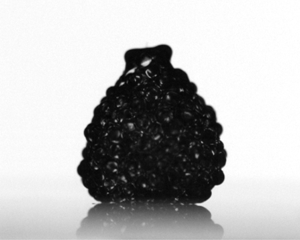Published online by Cambridge University Press: 01 June 2020

We study the impact between a plate and a drop of non-colloidal solid particles suspended in a Newtonian liquid, paying specific attention to the case when the particle volume fraction,  $\unicode[STIX]{x1D719}$, is close to – or even exceeds – the critical volume fraction,
$\unicode[STIX]{x1D719}$, is close to – or even exceeds – the critical volume fraction,  $\unicode[STIX]{x1D719}_{c}$, at which the steady effective viscosity of the suspension diverges. We use a specific concentration protocol together with an accurate determination of
$\unicode[STIX]{x1D719}_{c}$, at which the steady effective viscosity of the suspension diverges. We use a specific concentration protocol together with an accurate determination of  $\unicode[STIX]{x1D719}$ for each drop, and we measure the deformation
$\unicode[STIX]{x1D719}$ for each drop, and we measure the deformation  $\unicode[STIX]{x1D6FD}$ for different liquid viscosities, impact velocities and particle sizes. At low volume fractions,
$\unicode[STIX]{x1D6FD}$ for different liquid viscosities, impact velocities and particle sizes. At low volume fractions,  $\unicode[STIX]{x1D6FD}$ is found to follow closely an effective Newtonian behaviour, which we determine by documenting the low-deformation limit for a highly viscous Newtonian drop and characterizing the effective shear viscosity of our suspensions. By contrast, whereas the effective Newtonian approach predicts that
$\unicode[STIX]{x1D6FD}$ is found to follow closely an effective Newtonian behaviour, which we determine by documenting the low-deformation limit for a highly viscous Newtonian drop and characterizing the effective shear viscosity of our suspensions. By contrast, whereas the effective Newtonian approach predicts that  $\unicode[STIX]{x1D6FD}$ vanishes at
$\unicode[STIX]{x1D6FD}$ vanishes at  $\unicode[STIX]{x1D719}_{c}$, a finite deformation is observed for
$\unicode[STIX]{x1D719}_{c}$, a finite deformation is observed for  $\unicode[STIX]{x1D719}>\unicode[STIX]{x1D719}_{c}$. This finite deformation remains controlled by the suspending liquid viscosity and increases with increasing particle size, which suggests that the dilatancy of the particle phase is a key factor in the dissipation process close to and above
$\unicode[STIX]{x1D719}>\unicode[STIX]{x1D719}_{c}$. This finite deformation remains controlled by the suspending liquid viscosity and increases with increasing particle size, which suggests that the dilatancy of the particle phase is a key factor in the dissipation process close to and above  $\unicode[STIX]{x1D719}_{c}$.
$\unicode[STIX]{x1D719}_{c}$.